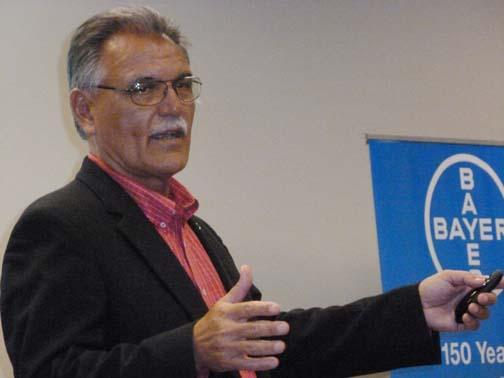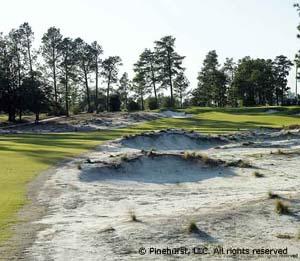 The saying "less is more" never has been more true than when used to describe the new look at Pinehurst No. 2.
The saying "less is more" never has been more true than when used to describe the new look at Pinehurst No. 2.As the finishing touches are applied to the 1907 Donald Ross gem in advance of the U.S. Open and U.S. Women's Open that are scheduled to be contested over successive weeks, the course will be nothing like the No. 2 on which Michael Campbell won in 2005 or the late Payne Stewart in 1999.
Prior to the 2010-12 Bill Coore-Ben Crenshaw restoration, there were 1,150 irrigation heads spread across No. 2. Today, there are 450, only about 70 of which are in the fairways, says Bob Farren, CGCS, director of grounds and golf course maintenance at Pinehurst Resort.
"We were fully irrigated before the project," Farren said when speaking about the Open and the restoration at an educational event last year in North Carolina. "In 2009, we receive 48 inches of rain per year, we irrigated (No. 2) with 50 to 55 million gallons of water. (In 2012) we used 12 million gallons."
Thanks to a treasure trove of vintage photos, the course has been rolled back to look pretty much like it did in 1936 when Denny Shute won the PGA Championship, the first of many majors to be contested on No. 2.
The restoration, which Farren says redefines minimalist architecture, also meant removing a lot of turf, especially in the roughs. That 5-inch stand of turf outside the fairways that has become synonymous with U.S. Opens, is gone. Those rough areas that have confounded golfers in past Open championships have been replaced by natural sand waste areas and native plants, including thousands of individual wiregrass plants transplanted from nearby woods. Otherwise, those natural areas pretty much have been left to recover on their own.
In all, about 40 acres of turf have been peeled away, along with some 30 years of changes that have taken place during Farren's career at Pinehurst that began in 1982.
"The key to taking away turf was we had to take away irrigation first," Farren said. "The common link to everything we had done all went back to water.
"(Coore and Crenshaw) were sensitive to my emotional attachment to it because my body of work as a professional was going away. At the same time, I bought in 100 percent that what we were doing was the right thing to do. Part of the reason (No. 2) had changed over the years was us chasing the market and providing what clients and members wanted and were used to seeing in the 1980s and '90s. Turning it back in a lot of ways was as simple as turning off the water and removing 40 acres of grass."
With the help of Kevin Stallings, a Ph.D. candidate at North Carolina State University, nearly four-dozen native plant species have been recorded in those natural areas alone.
"When you take away the grass, what is going to grow back?" Farren said. "There is no fertilizer, no herbicides. The only thing we planted was wiregrass. Forty-six plants recovered naturally, and the plant life changes from month to month."
That list includes plants such as morning glory, cactus and portulaca.
 "The only plants we have a zero tolerance for are nutsedge, goosegrass and large crabgrass," Farren said. "The others, we like to watch it and see what happens.
"The only plants we have a zero tolerance for are nutsedge, goosegrass and large crabgrass," Farren said. "The others, we like to watch it and see what happens."When they're succulent, weeds like henbit have a pretty little flower on it. It's not a weed until there are too many of them, or they are too mature."
Those waste areas will present a U.S. Open venue the likes of which probably have not been seen for decades.
"This is going to be much different than a normal event," Farren said, pointing to the 2013 U.S. Open at Merion Golf Club as an example. "At Merion, if you step 10 feet outside the rope, you have 5-inch grass and its been walked on so it's laying down. Here, if you go 10 feet outside the rope, it's going to be like a cattle crossing."
This year will mark the first time the U.S. Open, scheduled for June 12-15, and U.S. Women's Open will have been played in successive weeks on the same course. Weather challenges or a 72-hole tie in the men's championship could threaten to undo years of meticulous planning.
"It will either be historical, or hysterical. I'll let you know," Farren said. "I think it will be a mix of both. We are humbled the USGA has recognized our golf course as being a good test for this, and secondly, that the USGA has that much confidence in us to do this."
Much of what makes events in the Carolinas sandhills run so smoothly, Farren said, is community support. With only about 30,000 people in the surrounding area, there isn't a large pool of people from which to draw for help, but the community supports such events here with vigor, to the tune of some 6,500 volunteers from throughout the area.
"They have a strong golf DNA, and they are very involved in the community and give back," Farren said.
"We're in the middle of nowhere, but in the center of everything."
Within days of the last putt dropping and signaling the end of the U.S. Women's Open, No. 2 will go under the knife again, this time replacing the A1/A4 bentgrass greens with Champion ultradwarf Bermudagrass.
To help the Pinehurst staff prepare for Bermuda, No. 1 was regrassed with Champion in 2012 and Nos. 3 and 8 in 2013.
"We're working on our game with that," Farren said. "For our business model, it's a huge step forward for us. When we have the next U.S. Open here, we'll have great greens in ultradwarf."

